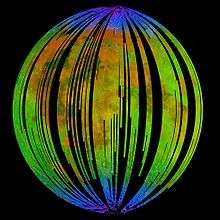ispace (Japanese company)
| Lunar robotic spacecraft | |
| Industry | Lunar mining |
| Fate | Active |
| Predecessor | White Label Space[1] |
| Founded | September 10, 2010 in Tokyo, Japan |
| Founder | Takeshi Hakamada |
| Headquarters | Tokyo, Japan |
| Products | Robotic lunar landers and rovers |
Number of employees | 50 [1] (2018) |
| Website |
ispace-inc |
ispace Inc. is a private Japanese company developing robotic spacecraft technologies to discover, map, and utilize the natural resources on the Moon. They will start by exploring the exploitation of lunar water in order to create a sustainable infrastructure and a Moon-based economy.[2] ispace's long-term strategy is to build landers and rovers to compete for both transportation and exploration mission contracts from space agencies and private industry.
In 2010 White Label Space Japan was founded as a branch organization to the Dutch-led Google Lunar X prize (GLXP) team White Label Space.[3] ispace was founded in 2013 after White Label Space dropped out from the GLXP and transferred its GLXP participation right to White Label Space Japan. ispace is currently headquartered in Tokyo, Japan with offices in the United States and Luxembourg.[4] The company's founder and CEO is Takeshi Hakamada.
ispace operates team Hakuto and their lunar rover, Sorato, that will scout for water and explore other potential local resources.
History
Although ispace is now independent, it began as a branch of a European organization called White Label Space.[1] White Label Space (WLS) was an international team of space engineers that was founded in 2008 to compete in the Google Lunar X Prize, for a grand price of $20 million to send a spacecraft to the Moon's surface, and have it travel 500 meters. WLS was headquartered in the Netherlands and led by Steve Allen.[5] The European side was to develop a lander, while the Japanese group consisting of Tohoku University Space Robotics Lab and led by Kazuya Yoshida was to develop a rover. In 2010, White Label Space Japn LLC, the predecessor of ispace was founded by Takeshi Hakamada to manage the commercial and technical aspect of the Japanese group.[3] When the European teammates dropped out from GLXP in January 30, 2013, the Japan-based members continued the work and the GLXP participation right was transferred from the Netherlands to Japan. Steve Allen, WLS's leader was succeeded by Takeshi Hakama. In May 2013, the team's parent company, White Label Space Japan changed its name to ispace, while WLS itself was renamed team Hakuto in July 15 of the same year.[1] As per September 2018, Ispace plans to orbit its lunar lander around the moon. The company has signed up for two launches on SpaceX's Falcon 9 rockets, to take place in 2020 and 2021.[6][7]
Overview

The long-term strategy of ispace is to build landers and rovers to compete for both transportation and exploration mission contracts from space agencies and private industry. They aim at mining lunar water and other resources to support a future Moon-based infrastructure.[8]
The first demonstration mission includes a small rover called Sorato which is planned to be delivered to the lunar surface by the Peregrine lander built Astrobotic Technology, to be launched on an Atlas V rocket in 2020.[9] The second demonstration mission includes a lander currently being designed by ispace, that would deploy a number of small rovers. The lander would be launched as a secondary payload on a commercial launch vehicle.[10]
If the technology validations are successful, ispace plans to offer a regular series of lander missions to carry up to 30 kilograms (66 lb) of customer payloads per flight.[10] The company also plans to collect a wide variety of data about the Moon's environment, which they plan to sell to its customers.[11]
Investors
The funding for the first two missions has been secured from a consortium of Japanese funds and companies that include:[10][12][13]
See also
- Colonization of the Moon
- Lunar water
- Private spaceflight
- Hakuto
- Moon Express, a similar company aiming to mine the moon
References
- 1 2 3 4 The Japanese Space Bots That Could Build Moon Valley. Sarah Scoles, Wired. 14 May 2018.
- ↑ ispace Home site. Accessed 11 September 2018.
- 1 2 "WLS Japan Office - Open For Business" (Press release). White Label Space. September 9, 2010. Retrieved September 12, 2018.
- ↑ Luxembourg and ispace, a Tokyo-Based Lunar Robotic ExplorationCompany, Sign MoU to Co-Operate within the Spaceresources.lu Initiative. Business Wire. Released by the Luxembourg Ministry of the Economy. 2 March 2017.
- ↑ Dutch Firm AOES Group BV Partners with White Label Space Team in $30 Million Google Lunar X PRIZE, 31 August 2009
- ↑ "Japan lunar exploration firm to head for moon on SpaceX rockets". Japan lunar exploration firm to head for moon on SpaceX rockets (in Turkish). Retrieved 2018-10-01.
- ↑ "Japanese company ispace says it will launch two missions to the Moon in 2020 and 2021". The Verge. Retrieved 2018-10-01.
- ↑ They want moon landings to be a commercial reality — and that's just the start. Time Romero, Tech in Asia. August 2018.
- ↑ Astrobiotic Ready to Become Delivery Service to the Moon. Michael Coli, Spaceflight Insider. 19 March 2018.
- 1 2 3 New fund to boost Japanese space startups. Jeff Foust, SpaceNews. 21 March 2018.
- ↑ This Japanese Space Startup Raised $90.2 Million To Go To The Moon. Alex Knapp, Forbes. 13 December 2017.
- ↑ Japan startup smashes SpaceX record, eyes moon landing by 2020 Russia Today. 13 December 2017.
- ↑ ispace. Tech in Asia. August 2018.
External links
- Official website
- White Label Space Japan (in Japanese)

